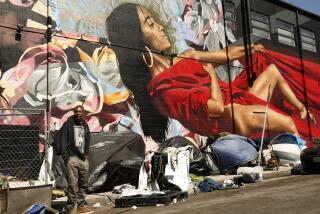After failed attempt, South L.A. wins Promise Zone designation, which could bring in money
After several unsuccessful attempts, a swath of South Los Angeles won a hard-fought battle to receive “Promise Zone” designation, a move that pushes the neediest neighborhoods to the top of the list when applying for competitive federal grants to tackle issues related to poverty.
Federal and local leaders made the announcement Monday at a news conference, flanked by college and high school students from Los Angeles Trade-Technical College. They hugged and cheered over an accomplishment that had become something of a mission.
“We have been able to clear the mission to improve the lives of brothers and sisters in need,” said Councilman Curren Price, who represents parts of the area. “We will soon have another powerful tool under our belt to rewrite the South L.A. story.”
Mayor Eric Garcetti said in a statement that “this will bring new resources, energy, and urgency into our movement to expand opportunity in all of L.A.’s neighborhoods.”
In 2014, when President Obama created Promise Zones to help struggling communities recover from the Great Recession, South L.A. did not meet the requirements, according to officials.
See the most-read stories this hour >>
The city was one of five in the U.S. to earn the status, but for neighborhoods bounded by Hollywood, MacArthur Park and Koreatown. Some South L.A. residents and community leaders were angered at falling short.
“We thought that the way that Promise Zones were organized that we would be prime in South L.A. to get the Promise Zone,” Congresswoman Maxine Waters said at Monday’s announcement. “However, we learned a lot about the criteria and how it was all put together. ”
That fall, Larry Frank, president of Los Angeles Trade-Technical College, led the charge in putting in a second application with support from USC, the Los Angeles Unified School District and more than 40 other community partners. But, once again, South L.A. didn’t make the cut.
After the failed attempt, the Department of Housing and Urban Development met with Frank and others to show them where their application was failing. It turned out South L.A. had scored low points in the areas of housing need and unemployment.
“Unless we changed the way they were going to score these Promise Zones applications, we were dead,” Frank said.
The way the federal government evaluated housing need was based on the number of foreclosures that sit empty.
“That’s a Detroit measure, not a South L.A. measure,” Frank said. “In South L.A. we have three families fighting for a single apartment and living in a single apartment. We have the worst homelessness in America. We have an unaffordability crisis in L.A.”
U.S. Secretary of Housing and Urban Development Julian Castro took a tour of the region to better understand the problems that plagued the community. Over the next year, the community leaders refined their application for Promise Zone status and lobbied the federal government to change the way it graded South L.A.’s bid.
This time South L.A. was chosen.
South L.A. is one of 13 communities in the nation picked in the final round of Promise Zones designations. Los Angeles is the only city to have had two designations within its city boundaries.
The new zone will straddle major transit lines of the Exposition, Blue and Crenshaw/LAX lines as well as the proposed Vermont bus rapid transit line. The boundaries include about 200,000 residents living in parts of Crenshaw, Leimert Park, Exposition Park, University Park, Historic South-Central, Central-Alameda, Florence and downtown Los Angeles.
“One of the goals is how does the community realize opportunities of the transportation investments without having mass displacement,” said Councilman Marqueece Harris-Dawson, who represents parts of South L.A.
Harris-Dawson worked as the president of the Community Coalition, a South L.A.-based nonprofit organization, when South L.A. was skipped over in the first round of designations.
“We thought it was definitely an injustice,” he said. “But we licked our wounds, we got in the room, and tried to come up with something so innovative and so powerful that the federal government can’t resist and that has been accomplished now. It’s a really bright and shiny moment.”
These are the final nine Promise Zones across the country in high poverty areas, according to a release by the U.S. Department of Housing. Eight other communities include Atlanta; Nashville, Tenn.; San Diego; Evansville, Ind.; Southwest Florida Regional Planning Commission; Spokane Tribe of Indians, Washington state; Turtle Mountain Band of Chippewa Indians, Rolette County, N.D.; and Roosevelt Roads, Puerto Rico.
MORE LOCAL NEWS
Third-grader barred from wearing Trump hat at California school
After failed attempt, South L.A. wins Promise Zone designation, which could bring in money
California congressional races to watch Tuesday
For more California breaking news, follow me on Twitter at @AngelJennings. She also can be reached at angel.jennings@latimes.com.
UPDATES:
5:50 p.m.: This article was updated with additional details.
More to Read
Start your day right
Sign up for Essential California for news, features and recommendations from the L.A. Times and beyond in your inbox six days a week.
You may occasionally receive promotional content from the Los Angeles Times.







